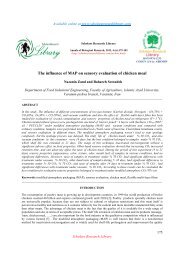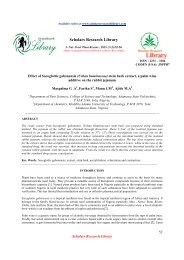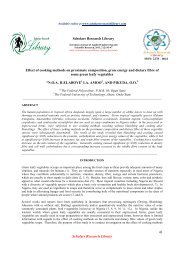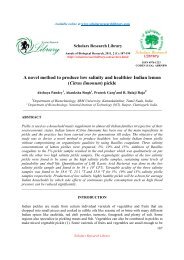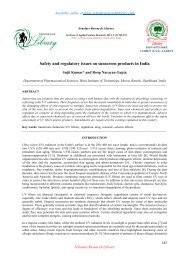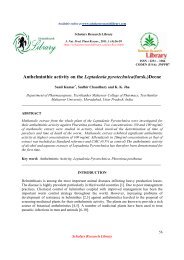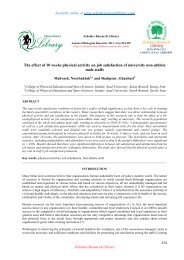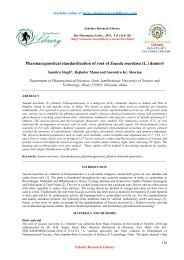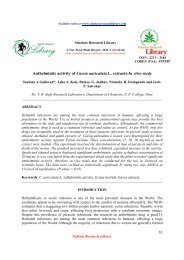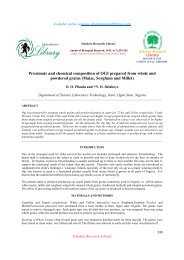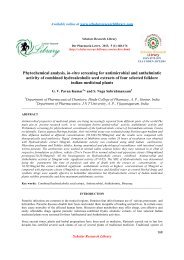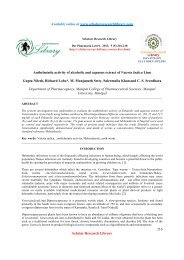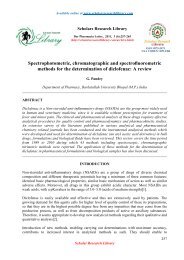Developmental changes in amniotic fluid vascular endothelial ...
Developmental changes in amniotic fluid vascular endothelial ...
Developmental changes in amniotic fluid vascular endothelial ...
You also want an ePaper? Increase the reach of your titles
YUMPU automatically turns print PDFs into web optimized ePapers that Google loves.
Available onl<strong>in</strong>e at www.scholarsresearchlibrary.com<br />
Scholars Research Library<br />
Annals of Biological Research, 2011, 2 (1) :94-99<br />
(http://scholarsresearchlibrary.com/archive.html)<br />
ISSN 0976-1233<br />
CODEN (USA): ABRNBW<br />
<strong>Developmental</strong> <strong>changes</strong> <strong>in</strong> <strong>amniotic</strong> <strong>fluid</strong> <strong>vascular</strong> <strong>endothelial</strong><br />
growth factor levels of chick embryos<br />
Farhad Mashayekhi 1 , Shariat Zahiri 1 , Ebrahim Mirzajani 2 and Ali Nickpay 1<br />
1 Department of Biology, Faculty of Sciences, University of Guilan, Rasht, Iran<br />
2 Department of Biochemistry, Faculty of Medic<strong>in</strong>e, Guilan University of Medical Sciences, Rasht, Iran<br />
_____________________________________________________________________________<br />
ABSTRACT<br />
Vascular <strong>endothelial</strong> growth factor (VEGF) is an <strong>endothelial</strong> cell-specific mitogen that <strong>in</strong>creases<br />
peripheral oxygen delivery by stimulat<strong>in</strong>g angiogenesis. VEGF is known to be expressed <strong>in</strong><br />
several fetus tissues and placenta. VEGF is <strong>in</strong>itially expressed <strong>in</strong> the yolk sac and <strong>in</strong> embryonic<br />
sites of vessels formation to support the assembly of a cardio<strong>vascular</strong> system. It is <strong>in</strong>structive not<br />
only for cardio<strong>vascular</strong> development, but also for the development of organ systems. The amnion<br />
form<strong>in</strong>g the <strong>amniotic</strong> cavity, provid<strong>in</strong>g an aqueous environment for the embryo. A wide range of<br />
prote<strong>in</strong>s <strong>in</strong>clud<strong>in</strong>g growth factors and cytok<strong>in</strong>es has been identified <strong>in</strong> human <strong>amniotic</strong> <strong>fluid</strong><br />
(AF). In this study, total prote<strong>in</strong> concentration (TPC) and VEGF level <strong>in</strong> the <strong>amniotic</strong> <strong>fluid</strong><br />
samples from chick embryos were measured us<strong>in</strong>g dye-based prote<strong>in</strong> assay and enzyme l<strong>in</strong>ked<br />
immunosorbent assay (ELISA). TPC decreased from days E6 to E10 and <strong>in</strong>creased from E11 to<br />
E15. However, the amount of AF VEGF was <strong>in</strong>creased from day E6 to E11 and thereafter the<br />
levels decreased from days E11 to E15. S<strong>in</strong>ce VEGF is important <strong>in</strong> the development of the<br />
organ systems, <strong>changes</strong> <strong>in</strong> the TPC and VEGF levels <strong>in</strong> AF dur<strong>in</strong>g chick embryonic development<br />
may be correlated with organ development. We have also concluded that VEGF is a constant<br />
component of chick AF.<br />
Keywords: <strong>amniotic</strong> <strong>fluid</strong>, <strong>vascular</strong> <strong>endothelial</strong> growth factor, concentration, chick.<br />
__________________________________________________________________<br />
INTRODUCTION<br />
Dur<strong>in</strong>g pregnancy, the fetus develops with<strong>in</strong> a <strong>fluid</strong> space surrounded by the <strong>amniotic</strong> <strong>fluid</strong> and<br />
chorionic membrane. With advanc<strong>in</strong>g gestation, the membranes expand and <strong>in</strong>crease <strong>in</strong> surface<br />
area to accommodate the grow<strong>in</strong>g fetus [1]. The importance of <strong>amniotic</strong> <strong>fluid</strong> (AF) growth factor<br />
for normal embryonic growth has been demonstrated <strong>in</strong> numerous studies [2]. In the human,<br />
Scholars Research Library<br />
94
Farhad Mashayekhi et al Annals of Biological Research, 2011, 2 (1):94-99<br />
_____________________________________________________________________________<br />
epithelial growth factor (EGF), transform<strong>in</strong>g growth factor -α (TGF-α) and hepatocyte growth<br />
factor are present <strong>in</strong> the AF and are thought to play <strong>in</strong> the development of respiratory system and<br />
stomach [3; 4]. In the ship, block<strong>in</strong>g of AF <strong>in</strong>gestion by the fetus results <strong>in</strong> abnormal<br />
development of the liver and gastro<strong>in</strong>test<strong>in</strong>al tract, and <strong>in</strong>hibit placental growth [5; 6]. It has been<br />
demonstrated that the swallow<strong>in</strong>g of AF growth factors is important <strong>in</strong> normal foetal<br />
development [7]. A wide range of prote<strong>in</strong> has been identified <strong>in</strong> AF. In humans, there are<br />
dynamic temporal patterns with AF total prote<strong>in</strong> concentrations from 7 to 20 weeks of gestation<br />
[8]. Foetal swallow<strong>in</strong>g represents the pr<strong>in</strong>ciple mechanism of clearance of AF prote<strong>in</strong>, which is<br />
thought to have a half-life of 1 to 2 days <strong>in</strong> monkeys. Growth factors and prote<strong>in</strong>s present <strong>in</strong> the<br />
AF can be taken up by the foetus [9] and can diffuse through the foetal sk<strong>in</strong> and can be absorbed<br />
by the <strong>vascular</strong>ized foetal surface of the placenta [10]. Changes <strong>in</strong> the concentrations of AF<br />
nerve growth factor (NGF) <strong>in</strong> the chick embryos and IGF-I and IGF-II <strong>in</strong> avian embryos has<br />
been demonstrated [11; 12]. Vascular <strong>endothelial</strong> growth factor (VEGF) is the most potent direct<br />
stimulator of <strong>vascular</strong> <strong>endothelial</strong> cell growth. VEGF also <strong>in</strong>duces <strong>vascular</strong> permeability and its<br />
expression is enhanced by hypoxia [13]. VEGF is known to be expressed <strong>in</strong> the placenta [14] and<br />
<strong>in</strong> several fetus tissues [15]. Two specific <strong>endothelial</strong> cell receptors, VEGFR-1 and VEGFR-1<br />
are known to b<strong>in</strong>d VEGF and a soluble form of VEGFR-1 has been identified [16; 17]. VEGF is<br />
<strong>in</strong>itially expressed at high level <strong>in</strong> the yolk sac and <strong>in</strong> embryonic sites of vessels formation to<br />
support the assembly of a cardio<strong>vascular</strong> system. However, VEGF cont<strong>in</strong>ues to be expressed<br />
after the onset of blood vessel formation, consistent with the idea that it is <strong>in</strong>structive not only for<br />
cardio<strong>vascular</strong> development, but also for the development of organ systems. In the adult, VEGF<br />
expression becomes restricted to specialized cell types <strong>in</strong> organs conta<strong>in</strong><strong>in</strong>g fenestrated<br />
endothelium, for example, the kidney and pituitary [18]. Several major growth factors upregulate<br />
VEGF, <strong>in</strong>clud<strong>in</strong>g epidermal growth factor (EGF), <strong>in</strong>sul<strong>in</strong> like growth factor-1 (IGF-1) and<br />
transform<strong>in</strong>g growth factor-α and -β (TGF-α and TGF-β)[19]. Moreover, <strong>in</strong>flammatory cytok<strong>in</strong>es<br />
and hormones have been shown to <strong>in</strong>duce VEGF expression [20].<br />
A wide range of prote<strong>in</strong>s <strong>in</strong>clud<strong>in</strong>g growth factors has been identified <strong>in</strong> AF [21]. These prote<strong>in</strong>s<br />
can enter the AF from the <strong>amniotic</strong> <strong>fluid</strong> cells, fetal ur<strong>in</strong>e, and of the foetal secretions that<br />
<strong>in</strong>clude transduction through foetal sk<strong>in</strong> [22]. As AF is <strong>in</strong> contact with the embryo, then<br />
biochemical modifications <strong>in</strong> the embryo could be detected <strong>in</strong> the AF. In this study, total prote<strong>in</strong><br />
concentration (TPC) and VEGF levels <strong>in</strong> the AF from chick embryos were studied us<strong>in</strong>g<br />
Bradford dye procedure and enzyme l<strong>in</strong>ked immunosorbent assay (ELISA).<br />
MATERIALS AND METHODS<br />
Amniotic <strong>fluid</strong> samples<br />
Fertile white Leghorn eggs were <strong>in</strong>cubated at 38 o C <strong>in</strong> a humidified atmosphere to obta<strong>in</strong> chick<br />
embryos at different stages of development. The <strong>amniotic</strong> <strong>fluid</strong> was carefully aspirated us<strong>in</strong>g a<br />
pulled tip glass microcapillary pipette (Drummond Scientific Company, 20 µL) from <strong>in</strong>cubated<br />
chicks embryos from day 6 to day 15 (E6 to E15).<br />
Amniotic <strong>fluid</strong> for each analysis was collected from 28 chick embryos. The average amount of<br />
0.5 ml <strong>amniotic</strong> <strong>fluid</strong> was collected from each embryo. To m<strong>in</strong>imize prote<strong>in</strong> degradation,<br />
<strong>amniotic</strong> <strong>fluid</strong> samples were kept at 4 °C dur<strong>in</strong>g collection. Amniotic <strong>fluid</strong> samples were<br />
centrifuged at 15000 rpm at 4 °C for 10 m<strong>in</strong>utes to remove any contam<strong>in</strong>at<strong>in</strong>g cells. The samples<br />
Scholars Research Library<br />
95
Farhad Mashayekhi et al Annals of Biological Research, 2011, 2 (1):94-99<br />
_____________________________________________________________________________<br />
that we used for analysis had no visible sign of contam<strong>in</strong>at<strong>in</strong>g red blood cells that we could<br />
detect under the microscope. The supernatant was frozen immediately and stored at -70 o C until<br />
future analysis. Twenty eight samples from each time po<strong>in</strong>t were used for analysis of total<br />
prote<strong>in</strong> concentration and NGF level.<br />
Total prote<strong>in</strong> and NGF analysis<br />
The total prote<strong>in</strong> concentration of prote<strong>in</strong>s <strong>in</strong> <strong>amniotic</strong> <strong>fluid</strong> was determ<strong>in</strong>ed by the Bio-Rad<br />
prote<strong>in</strong> assay based on the Bradford dye procedure. VEGF <strong>in</strong> <strong>amniotic</strong> <strong>fluid</strong> was measured us<strong>in</strong>g<br />
the sensitive two-site ELISA and antiserum aga<strong>in</strong>st chick VEGF. Microtiter plates (Dynatech,<br />
Canada) were first coated with 80 ng primary anti-VEGF antibody (Abcam) per well <strong>in</strong> 0.1 M<br />
Tris buffer. After overnight <strong>in</strong>cubation, the plates were blocked with EIA buffer (50 mM Tris pH<br />
7.5, 0.3 M NaCl, 0.1% Triton X-100, 1% BSA and 1% gelat<strong>in</strong>). The samples and standards were<br />
placed <strong>in</strong> triplicate wells and <strong>in</strong>cubated overnight at room temperature. After wash<strong>in</strong>g with<br />
phosphate buffered sal<strong>in</strong>e (PBS) a biot<strong>in</strong>ylated secondary antibody (7 ng/mL) was added to each<br />
well and <strong>in</strong>cubation was carried out overnight at room temperature. β-galactosidase coupled to<br />
avid<strong>in</strong> was then added for 2 hours followed by wash<strong>in</strong>g. F<strong>in</strong>ally, 200 µM 4-methylumbelliferylβ-galactoside<br />
(Sigma-Aldrich, Poole, UK) <strong>in</strong> 50 mM sodium phosphate were added as well as 10<br />
mM MgCl2 buffer and the amount of fluorescence was measured after 50 m<strong>in</strong>utes <strong>in</strong>cubation at<br />
37 o C us<strong>in</strong>g a fluorimeter (Dynatech, Canada).<br />
All animal procedures were carried out <strong>in</strong> accordance with the Animals, Act, 1986. All values<br />
were expressed as mean±standard error of the mean (SEM). In all experiments, a m<strong>in</strong>imum of 28<br />
measurements were made <strong>in</strong> order to calculate a mean±SEM. Statistical analysis was performed<br />
us<strong>in</strong>g Student's t test and only values with P≤0.05 were considered statistically significant.<br />
RESULTS<br />
Total prote<strong>in</strong> concentration<br />
The total prote<strong>in</strong> concentration <strong>in</strong> AF <strong>in</strong> embryos aged E6 to E15 was determ<strong>in</strong>ed by Bio-Rad<br />
prote<strong>in</strong> assay. The total prote<strong>in</strong> concentration decreased from day E6 to day E10 and after that<br />
the levels <strong>in</strong>creased from E11 to E15 (Figure 1).<br />
Amniotic <strong>fluid</strong> total prote<strong>in</strong> concentration<br />
0:36<br />
0:28<br />
0:21<br />
g/L<br />
0:14<br />
0:07<br />
0:00<br />
E6 E7 E8 E9 E10 E11 E12 E13 E14 E15<br />
Embryonic days<br />
Figure 1. Total prote<strong>in</strong> concentration <strong>in</strong> the <strong>amniotic</strong> <strong>fluid</strong> samples from days E6 to E15 (g/l). (n=28 at each time po<strong>in</strong>t)<br />
Scholars Research Library<br />
96
Farhad Mashayekhi et al Annals of Biological Research, 2011, 2 (1):94-99<br />
_____________________________________________________________________________<br />
VEGF concentration<br />
Us<strong>in</strong>g ELISA, we have also analyzed VEGF concentrations <strong>in</strong> the AF samples from chick<br />
embryos aged E6 to E15. The amount of AF VEGF was <strong>in</strong>creased from day E6 to E11 and<br />
thereafter the levels decreased from days E11 to E15 (Figure 2).<br />
Figure 2. Vascular <strong>endothelial</strong> growth factor concentration <strong>in</strong> the <strong>amniotic</strong> <strong>fluid</strong> samples from days E6 to E15 (pg/ml).<br />
(n=28 at each time po<strong>in</strong>t).<br />
DISCUSSION<br />
In this study we <strong>in</strong>vestigated the TPC and VEGF levels <strong>in</strong> the chick AF. We <strong>in</strong>vestigated VEGF<br />
as it is one of the most important growth factor that plays a key role <strong>in</strong> the organogenesis<br />
<strong>in</strong>clud<strong>in</strong>g the development of cardio<strong>vascular</strong> system [23]. It has also been shown that VEGF<br />
signal<strong>in</strong>g is important <strong>in</strong> the development of endoderm-derived organs <strong>in</strong>clud<strong>in</strong>g liver and<br />
pancreas [24].<br />
VEGF is a potent stimulator of cardio- and angiogenesis. The extensive fetal and placental tissue<br />
growth of normal pregnancy is characterized by a strong local demand for <strong>vascular</strong> expansion,<br />
but so far little is known about factors regulat<strong>in</strong>g VEGF <strong>in</strong> human pregnancy. VEGF is essential<br />
for fetal development because the loss of only one copy of the VEGF gene leads to embryonic<br />
lethality [25]. VEGF exerts its biological effects through VEGFR-1 and VEGFR-2. VEGFR-2 is<br />
the major mediator of mitogenic, angiogenic and permeability enhanc<strong>in</strong>g and <strong>endothelial</strong><br />
survival properties of VEGF [26]. VEGF was identified <strong>in</strong> human AF [27].<br />
The amnion, which surrounds the embryo, form<strong>in</strong>g the <strong>amniotic</strong> cavity, provid<strong>in</strong>g an aqueous<br />
environment for the embryo. The amnion conta<strong>in</strong>s a <strong>fluid</strong> to protect the embryo from mechanical<br />
and thermal shock, possesses antimicrobial activity and conta<strong>in</strong>s nutritional and growth factors.<br />
A wide range of prote<strong>in</strong>s has been identified <strong>in</strong> human AF [21]. In humans, these growth factors<br />
can enter the AF from the maternal uter<strong>in</strong>e tissues, umbilical cord, fetal ur<strong>in</strong>e and other fetal<br />
secretions that <strong>in</strong>clude transduction through fetal sk<strong>in</strong> [22].<br />
Scholars Research Library<br />
97
Farhad Mashayekhi et al Annals of Biological Research, 2011, 2 (1):94-99<br />
_____________________________________________________________________________<br />
As AF conta<strong>in</strong>s growth factors and it has been shown that the swallow<strong>in</strong>g of AF is important <strong>in</strong><br />
normal fetal development [7], thus, <strong>in</strong> this study the <strong>changes</strong> <strong>in</strong> the total prote<strong>in</strong> concentration<br />
(TPC) and VEGF levels have been studied. In this study, we showed that TPC <strong>in</strong> AF <strong>in</strong>creases<br />
from day E6 to day E18. This result is consistent with the f<strong>in</strong>d<strong>in</strong>g that human AF TPC ris<strong>in</strong>g as<br />
pregnancy proceeds [28]. We have also shown that there is a change <strong>in</strong> AF VEGF concentration<br />
dur<strong>in</strong>g chick embryonic development. AF VEGF levels <strong>in</strong>creases from E10 to E15 and decreased<br />
from E11 to E18. VEGF is important <strong>in</strong> the organogenesis and <strong>changes</strong> <strong>in</strong> AF VEGF<br />
concentration has been seen <strong>in</strong> some diseases [29]. Changes <strong>in</strong> the TPC and VEGF levels dur<strong>in</strong>g<br />
chick embryonic development may be associated with organ development. S<strong>in</strong>ce AF is <strong>in</strong> contact<br />
with the develop<strong>in</strong>g embryo and the embryo swallow AF dur<strong>in</strong>g development, <strong>changes</strong> <strong>in</strong> the<br />
VEGF and TPC <strong>in</strong> the AF could affect the develop<strong>in</strong>g embryo.<br />
CONCLUSION<br />
It is thus concluded that VEGF is a constant component of AF dur<strong>in</strong>g chick embryonic<br />
development and it might also be <strong>in</strong>volved <strong>in</strong> chick organogenesis.<br />
Acknowledgement<br />
This study was supported by the University of Guilan. We would like to thank all the people <strong>in</strong><br />
the Biochemistry laboratory, Guilan University of Medical sciences university for ELISA.<br />
REFERENCES<br />
[1] Brace RA. Placenta., 1995, 16, 1-18.<br />
[2] Diamandi A, Mistry J, Krishna RG, Khosravi J. J Cl<strong>in</strong> Endocr<strong>in</strong>ol Metab., 2000, 85, 2327-<br />
33.<br />
[3] Kelly EJ, Newell SJ, Brownlee KG, Farmery SM, Cull<strong>in</strong>ane C, Reid WA, Jackson P, Gray<br />
SF, Primrose JN, Lagopoulos M. Arch Dis Child Fetal Neonatal Ed. 1997, 76, F158-62.<br />
[4] Itakura A, Kurauchi O, Morikawa S, Furugori K, Mizutani S, Tomoda Y. Obstet Gynecol.,<br />
1997, 5, 729-33.<br />
[5] Trahair JF, Hard<strong>in</strong>g R. Virchows Arch A Pathol Anat Histopathol., 1992, 420, 305-12.<br />
[6] Avila CG, Hard<strong>in</strong>g R. J Pediatr Gastroenterol Nutr. 1991, 12, 96-104.<br />
[7] Kimble RM, Breier BH, Gluckman PD, Hard<strong>in</strong>g JE. J Endocr<strong>in</strong>ol., 1999, 162, 227-35.<br />
[8] Tisi DK, Emard JJ, Koski KG. J Nutr., 2004, 134, 1754-8.<br />
[9] Bloomfield FH, Breier BH, Hard<strong>in</strong>g JE. Pediatr Res., 2002, 51, 361-9.<br />
[10] Woods JR. Ann N Y Acad Sci. 1998, 21, 46:1-11.<br />
[11] Karcher DM, McMurtry JP, Applegate TJ. Comp Biochem Physiol A Mol Integr Physiol.,<br />
2005, 142, 404-9.<br />
[12] Mashayekhi Farhad, Elham Dianati and Lotfali Masomi Moghadam, Saudi Journal of<br />
Biological Sciences, In press.<br />
[13] Keck PJ, Hauser SD, Krivi G, Sanzo K, Warren T, Feder J, Connolly DT., Science. 1989, 8,<br />
246, 1309-12.<br />
[14] Sharkey AM, Charnock-Jones DS, Boocock CA, Brown KD, Smith SK. J Reprod Fertil.,<br />
1993, 99, 609-15.<br />
[15] Kaipa<strong>in</strong>en A, Korhonen J, Pajusola K, Aprelikova O, Persico MG, Terman BI, Alitalo K. J<br />
Exp Med., 1993, 178, 2077-88.<br />
Scholars Research Library<br />
98
Farhad Mashayekhi et al Annals of Biological Research, 2011, 2 (1):94-99<br />
_____________________________________________________________________________<br />
[16] Terman B, Khandke L, Dougher-Vermazan M, Maglione D, Lassam NJ, Gospodarowicz D,<br />
Persico MG, Böhlen P, Eis<strong>in</strong>ger M. Growth Factors., 1994, 11, 187-95.<br />
[17] Kendall RL, Thomas KA. Proc Natl Acad Sci U S A. 1993, 15, 10705-9.<br />
[18] Miquerol L, Langille BL, Nagy A. Development., 2000, 127, 3941-6.<br />
[19] Pagès G, Pouysségur J. Cardiovasc Res., 2005, 15, 564-73.<br />
[20] Fujita M, Mason RJ, Cool C, Shannon JM, Hara N, Fagan KA. J Appl Physiol., 2002, 93,<br />
2162-70.<br />
[21] Burdett P, Lizana J, Eneroth P, Bremme K. Cl<strong>in</strong> Chem., 1982, 28, 935-40.<br />
[22] Jauniaux E, Jurkovic D, Gulbis B, Coll<strong>in</strong>s WP, Zaidi J, Campbell S. Am J Obstet Gynecol.,<br />
1994, 170, 1365-9.<br />
[23] Goldie LC, Nix MK, Hirschi KK. Organogenesis., 2008, 4, 257-63.<br />
[24] Lammert E, Cleaver O, Melton D. Science. 2001, 19, 94, 564-7.<br />
[25] Ferrara N, Carver-Moore K, Chen H, Dowd M, Lu L, O'Shea KS, Powell-Braxton L, Hillan<br />
KJ, Moore MW. Nature., 1996, 4, 380, 439-42.<br />
[26] Ferrara N, Gerber HP, LeCouter J. Nat Med., 2003, 9, 669-76<br />
[27] Tranquilli AL, Bezzeccheri V, Scagnoli C, Mazzanti L, Garzetti GG. J Matern Fetal<br />
Neonatal Med. 2003 Jan;13(1):28-31<br />
[28] Benzie RJ, Doran TA, Hark<strong>in</strong>s JL, Owen VM, Porter CJ. Obstet Gynecol., 1974, 15, 798-<br />
810.<br />
[29] Vuorela P., Helske S., Hornig C., Alitalo K., Weich H., Halmesmäki E., Obstet Gynecol.,<br />
2000, 95, 353-7.<br />
Scholars Research Library<br />
99



